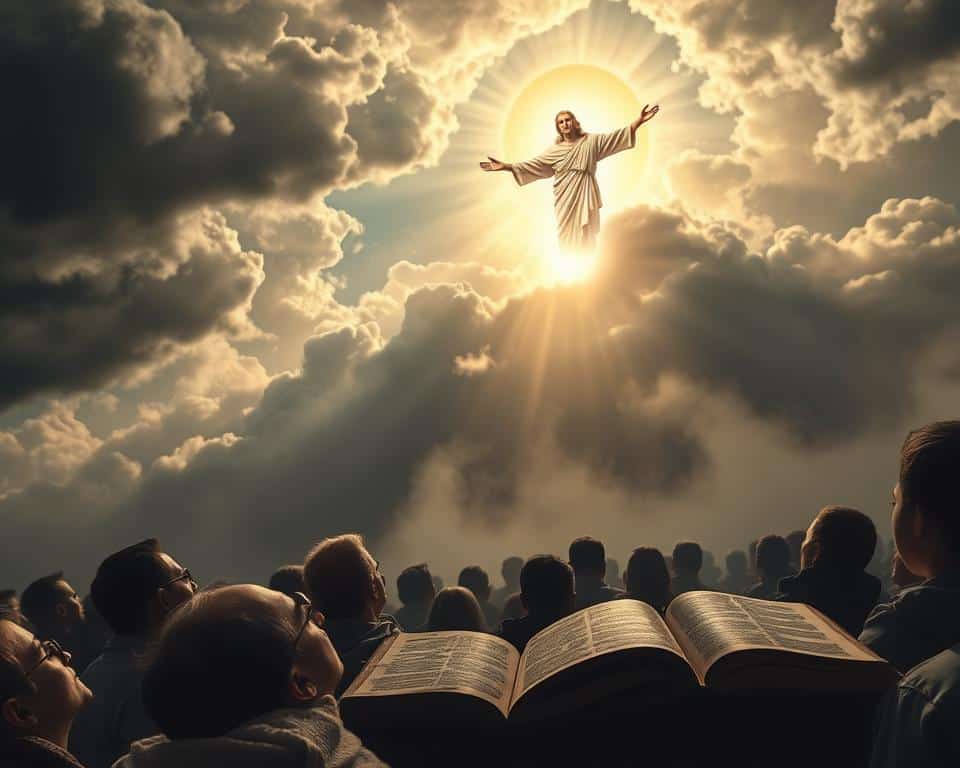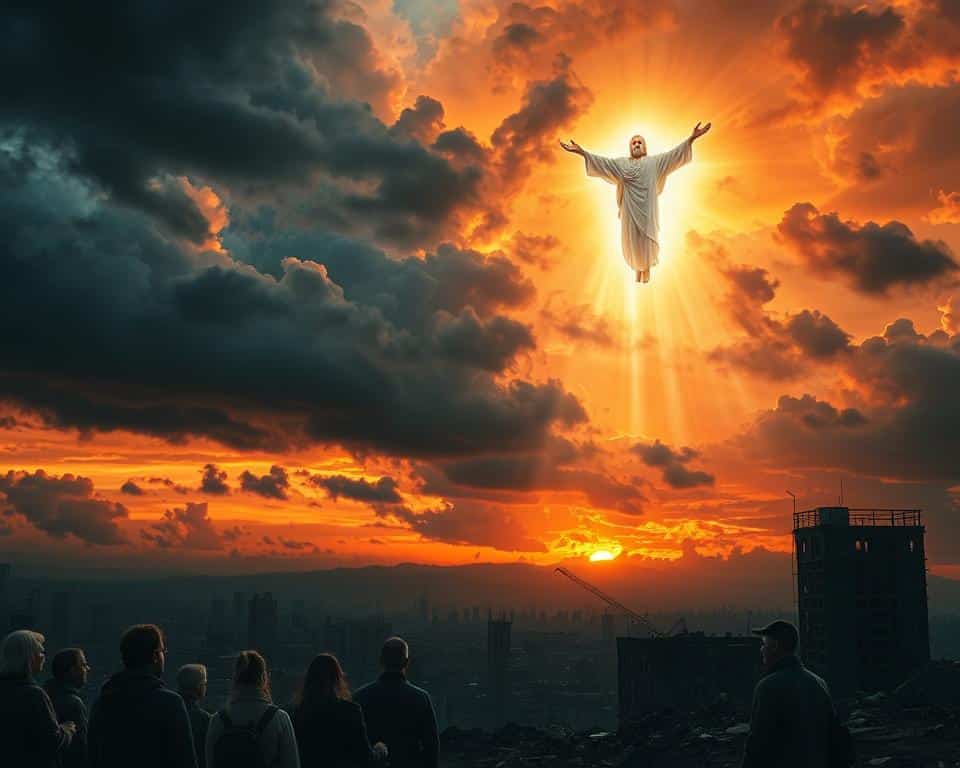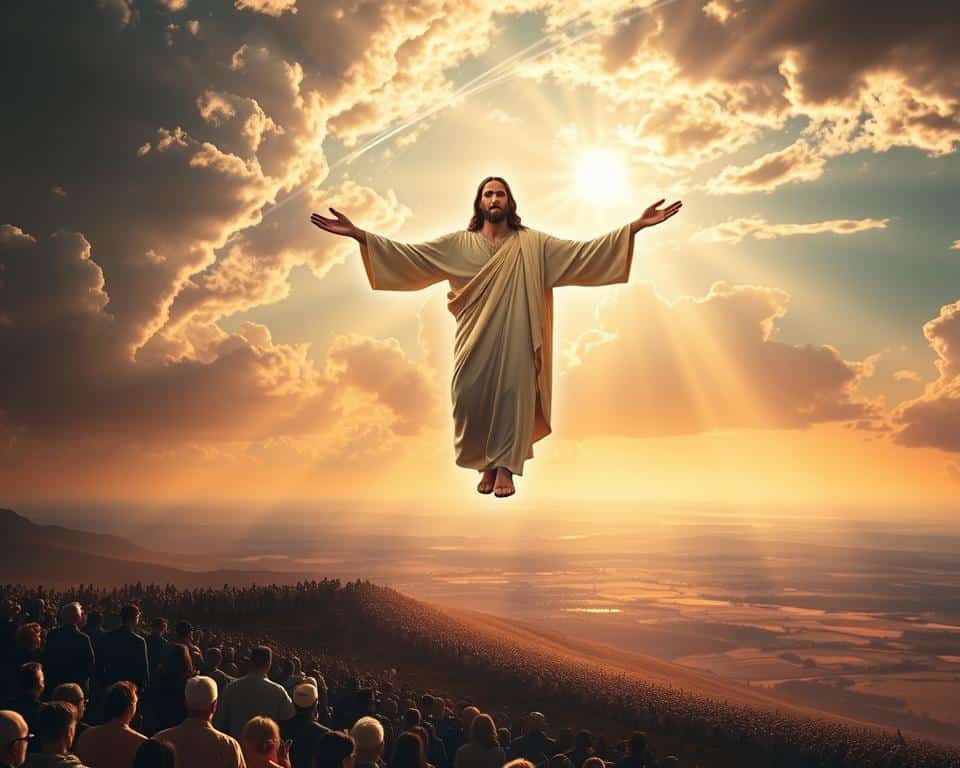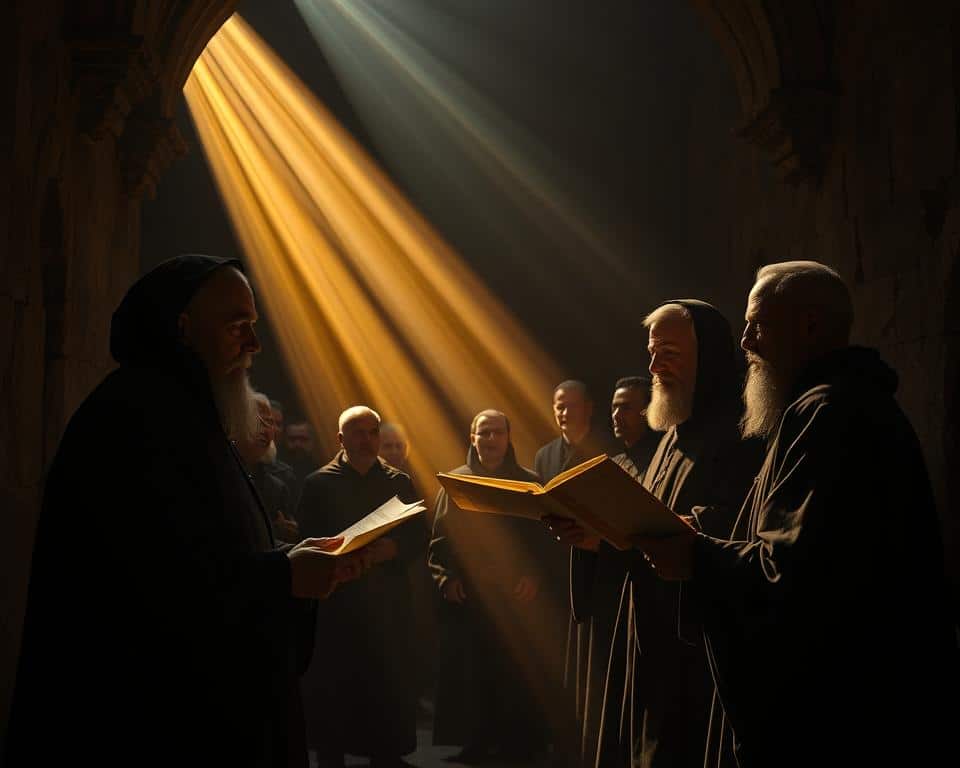Have you ever wondered what the Bible says about the future? Jesus Christ promised He would return, and Scripture gives us clear details about this monumental event. It’s not just a vague hope—it’s a literal, visible reality described in passages like Revelation 19:11-21.
This moment marks God’s ultimate plan for restoration. Imagine a world made new, where justice reigns and every promise is fulfilled. Acts 1:11 confirms it: Christ will come back just as He ascended—physically and gloriously.
Whether you’re seeking answers or deepening your faith, understanding this truth brings hope. Let’s explore what God’s word reveals about His coming and why it matters for you today.
Biblical Foundations of the Second Coming
Scripture lays a powerful foundation for understanding Christ’s return. Both testaments reveal God’s plan with striking clarity. Old Testament prophecies like Zechariah 14:4 pinpoint details—His feet will stand on the Mount of Olives, splitting the earth east to west.

Old Testament Prophecies
Daniel 7:13-14 describes the Son of Man approaching God’s throne to receive eternal dominion. This vision became central to Jesus’ identity. In Matthew 24:30, He directly references Daniel, confirming its fulfillment at His return.
Malachi 4:2 uses poetic imagery: “The Sun of Righteousness will rise with healing.” This mirrors Revelation’s depiction of Christ’s glory. Unlike symbolic OT language (Psalm 2), the New Testament offers literal descriptions.
New Testament Revelations
The apostles expanded these truths. Acts 1:11 echoes Zechariah’s geographic specificity, while Revelation 19:11-16 portrays Christ as a conquering king. New Testament revelations transform ancient hopes into concrete promises.
Key Events Surrounding the Second Coming
God’s word outlines key events leading to Christ’s return with unmistakable clarity. These moments aren’t random—they fulfill divine promises and reveal God’s justice. Let’s explore the pivotal stages Scripture highlights.

The Rapture of the Church
1 Thessalonians 4:16-17 describes the Rapture: believers will rise to meet Christ in the air. Angels will sound a trumpet, and those who trusted Him will be transformed instantly.
Views differ on timing. Some believe the Rapture happens before the tribulation, while others see it afterward. Either way, this event marks God’s faithfulness to His people.
The Great Tribulation
Daniel 9:27 reveals a seven-year period of unparalleled wrath. False peace treaties and temple rebuilding will deceive many. Jesus called this “tribulation such as has not been since the beginning of the world” (Matthew 24:21).
Yet, God remains sovereign. Even in judgment, His mercy calls people to repentance.
The Battle of Armageddon
Revelation 16:16 identifies the Battle of Armageddon as humanity’s final rebellion. Nations will gather against Christ, but His victory is certain.
“Out of His mouth comes a sharp sword to strike down the nations” (Revelation 19:15).
This clash ends with Christ establishing His eternal kingdom. What a hope for believers!
Signs of the Second Coming in Scripture
Jesus Himself described observable events that would precede His return. These signs aren’t hidden—they’re warnings and promises woven throughout Scripture. From global conflicts to spiritual deception, God’s word prepares us for what’s ahead.
Wars, Famines, and Earthquakes
Matthew 24:6-7 lists nation rising against nation as an initial sign. You’ll notice these conflicts intensify, paired with food shortages and natural disasters. Earthquakes, like birth pains, grow more frequent (Revelation 6:12).
Joel 2:30-31 foretold cosmic disturbances—blood, fire, and smoke. Acts 2:19-20 confirms their fulfillment. These aren’t random tragedies but divine markers pointing to Christ’s imminent return.
The Rise of False Prophets
2 Peter 2:1 warns about deceptive teachers who twist truth. History reveals stark examples, like David Koresh’s cult claiming messianic authority. Such false prophets exploit crises to mislead many.
Paul’s warning in 2 Thessalonians 2:3 is urgent: a “falling away” from faith will precede Christ’s return. Yet amid deception, God’s truth stands unshaken. Cling to Scripture, and you’ll discern light from darkness.
The Role of Jesus Christ in the Second Coming
The Bible reveals Jesus Christ in two distinct roles—humble servant and conquering King. At His first coming, He was the sacrificial Lamb (John 1:29). When He returns, He’ll come as the Lion of Judah (Revelation 5:5), fulfilling every promise of God’s justice and mercy.
His Return as King and Judge
Scripture shows Christ’s dual authority. As Judge, He’ll separate believers’ rewards (Bema Seat, 2 Corinthians 5:10) from final condemnation (Great White Throne, Revelation 20:11-15). His verdicts flow from perfect righteousness—no injustice stains His court.
Yet He’s also the crowned King. Revelation 19:16 declares His title: “On His robe and thigh He has this name written: KING OF KINGS AND LORD OF LORDS.” Every knee will bow to His sovereign rule.
The Establishment of His Kingdom
Isaiah 9:7 promises a government that never ends. During His millennial reign, society transforms—long life, peace, and productivity flourish (Isaiah 65:20-25). Nature itself obeys His command, as wolves dwell with lambs.
Zechariah 14:9 confirms universal worship: “The Lord will be king over the whole earth.” This unshakable kingdom, foretold in Daniel 2:44, culminates when “The seventh angel sounded his trumpet… and the kingdom of the world has become the kingdom of our Lord” (Revelation 11:15).
What a hope! Jesus Christ returns not just to end evil but to establish eternal goodness. His rule brings the perfection we long for—and Scripture guarantees it.
The Timing of the Second Coming
History is filled with failed attempts to pinpoint the time of Jesus’ return. From the Millerites’ 1844 disappointment to Harold Camping’s 2011 prediction, date-setting has repeatedly missed the mark. Scripture, however, offers wisdom—not exact dates—to guide our expectation.
Biblical Clues and Interpretations
Some groups, like Jehovah’s Witnesses in 1914 or Edgar Whisenant in 1988, misread lunar/solar calendars or symbolic words. Others misapplied generational markers from Matthew 24:34, assuming “this generation” meant their lifetime.
Jesus’ own words in Matthew 24:36 refute date-setting: “No one knows about that day or hour.” The focus isn’t on calculations but readiness. Even angels remain unaware (Mark 13:32).
Why No One Knows the Exact Date
God’s sovereignty is key. The Seventh-day Adventist Great Disappointment taught a vital lesson: human timelines fail. Imminence—living as if Christ could return any time—is the biblical model.
Rather than chasing signs, we’re called to faithfulness. As Paul urged, “Understand the present time” (Romans 13:11). The end will come suddenly, like a thief (1 Thessalonians 5:2). Our task? Stay watchful.
The Antichrist and the Second Coming
The Bible warns of a powerful figure who will oppose Christ before His return. This Antichrist isn’t a myth—Scripture details his rise, tactics, and ultimate defeat. From Daniel to Revelation, God’s word prepares us to recognize deception and cling to truth.
Identifying the Antichrist
John’s letters clarify a key distinction: many “antichrists” exist (1 John 2:18), but one final Antichrist will emerge. Daniel 9:27 describes him as a covenant-breaking leader. He’ll promise peace but desecrate God’s temple (2 Thessalonians 2:4).
Historically, figures like Nero or the papacy were labeled as the Antichrist. Yet Revelation 13:5-7 points to a future man with global influence. His 42-month reign will include:
- Economic control via the “mark of the beast” (Revelation 13:16-17).
- False miracles, echoing Pharaoh’s magicians (Exodus 7:11).
- Persecution of believers who refuse to compromise.
His Role in End-Time Events
This deceiver will rise during the tribulation, exploiting chaos to seize power. Revelation 13:2 shows Satan giving him authority—a counterfeit kingdom opposing Christ’s rule. Yet his events are limited. God permits his reign to test humanity’s allegiance.
“He will oppose and exalt himself above every so-called god” (2 Thessalonians 2:4).
Despite his temporary sway, Christ’s victory is certain. The Antichrist’s fate is sealed in Revelation 19:20—eternal judgment. For now, Scripture urges discernment. Stand firm in God’s word, and you’ll spot lies masquerading as light.
The Resurrection of the Dead
What happens after death? The Bible gives clear answers about the future resurrection. This isn’t a metaphor—Scripture describes a literal awakening of the dead, where every person who ever lived will stand before God. Two outcomes await, as starkly different as light and darkness.
Believers and Unbelievers
Jesus outlined two resurrections in John 5:28-29. The first is for those who trusted Him—they’ll rise to eternal life. The second is for those who rejected Him, awakening to “shame and everlasting contempt” (Daniel 12:2).
Believers receive glorified bodies, like Christ’s after His resurrection (1 Corinthians 15:52). These bodies are:
- Imperishable—no sickness or decay.
- Powerful—free from weakness.
- Spiritual—fully aligned with God’s will.
Unbelievers keep their natural bodies, unfit for eternity. Their fate is sealed by their choices.
The Final Judgment
Revelation 20:12-15 depicts the Great White Throne. Books recording deeds and the Book of Life are opened. Those not found in the Book of Life face the Lake of Fire—eternal separation from God.
“The sea gave up the dead that were in it, and death and Hades gave up the dead that were in them, and each person was judged according to what they had done” (Revelation 20:13).
For believers, judgment means reward (2 Corinthians 5:10). For unbelievers, it’s justice for unrepentant sin. The nations will see God’s fairness—no one will question His verdict.
The Millennial Reign of Christ
A golden age awaits—1,000 years of perfect peace under Christ’s direct rule. Revelation 20:2-3 describes this era, where Satan is bound and creation flourishes. You’ll see God’s original design for the earth fully restored.
What Scripture Reveals About the 1,000 Years
Two main views exist among believers. Premillennialists take Revelation 20 literally—Christ returns before the 1,000 years. Amillennialists see it symbolically, merging it with eternity. Both agree: God’s justice prevails.
Ezekiel 40-48 details temple worship during this time. Animal sacrifices will memorialize Christ’s death, not atone for sin. Resurrected saints will co-reign with Him (Revelation 20:4), governing nations with wisdom.
A Transformed World
Isaiah 11:6-9 shows nature redeemed: “The wolf will eat straw like the ox.” Pollution, extinctions, and climate crises vanish. Imagine:
- Farms yielding hundredfold harvests without drought
- Oceans teeming with life, free from plastic
- Cities where crime and poverty don’t exist
This isn’t fantasy—it’s God’s guaranteed restoration. As Jeremiah 31:12 promises, “They will rejoice in the bounty of the Lord.” The millennium offers a tangible foretaste of eternity.
Differences Between the Rapture and the Second Coming
Many believers confuse two major biblical events—the Rapture and Christ’s return—but Scripture clarifies their distinct roles. One prepares God’s people, while the other establishes His kingdom on earth. Let’s explore how they differ in timing, purpose, and who’s involved.
Timing and Purpose
1 Thessalonians 4:17 describes the Rapture: believers are “caught up” to meet Christ in the clouds. This happens before the tribulation, as Jesus promised in John 14:3 to prepare a place for His church.
In contrast, Revelation 19:14 shows Christ returning with His saints, not for them. The Second Coming ends the tribulation, with His feet touching the Mount of Olives (Zechariah 14:4). The gap? Roughly seven years.
Who Will Be Involved
The Rapture is for the church—living believers transformed instantly (1 Corinthians 15:52) and resurrected saints. At the Second Coming, angels accompany Christ (Matthew 25:31), and surviving mortals enter His millennial reign.
Think of it like a wedding: the Rapture is the bride being whisked away (Ephesians 5:27), while the Second Coming is the public ceremony. Both are joyous, but one is private; the other, universal.
“For the Lord Himself will descend from heaven with a shout… and the dead in Christ will rise first.” (1 Thessalonians 4:16)
God’s plan unfolds in stages. Knowing these differences helps you live with urgency and hope.
How Believers Should Prepare for the Second Coming
Living with urgency changes everything—how does your faith measure up? Jesus’ command in Matthew 24:42 is clear: “Watch therefore, for you do not know what hour your Lord is coming.” This isn’t about fear; it’s about faithful readiness. Here’s how to live with purpose as you await His return.
Living in Readiness
Start with daily self-examination. Ask: “Does my life reflect Christ’s priorities?” Peter urges holy conduct (2 Peter 3:11)—not perfection, but intentional growth. Try these practices:
- Verse mapping: Study prophecy passages like 1 Thessalonians 5:6, noting God’s promises and warnings.
- Emergency preparedness: Store essentials, but avoid hoarding. Trust God, yet steward resources wisely.
- Community vigilance: Join small groups focused on Scripture and prayer. Accountability fuels faithfulness.
Sharing the Hope of Christ’s Return
Hope is contagious. When you grasp the imminence of Christ’s return, it reshapes conversations. Use these approaches:
- Ask questions: “What do you think happens after death?” Listen first, then share Revelation 21:4.
- Highlight restoration: Describe the new earth—no pain, injustice, or death. People crave this hope.
- Live authentically: Your joy and peace will intrigue others more than debates.
“Since everything will be destroyed in this way, what kind of people ought you to be?”
Time is short, but God’s grace isn’t. Whether through service, generosity, or truth-sharing, let your life prepare the way for His kingdom. The best is yet to come.
The Hope and Promise of Christ’s Return
Christ’s return isn’t just an event—it’s the fulfillment of every longing. Titus 2:13 calls it our “blessed hope.” While the world fears the future, believers rest in God’s sovereignty. His timeline is perfect, and His promise is sure.
Unlike earthly anxiety, our peace comes from knowing the end of the story. Imagine the joy of the marriage supper of the Lamb (Revelation 19:9). Every tear wiped away. Every prayer answered. This is the hope Scripture offers.
Today, you can secure your eternal destiny. Trust in Christ, and His return becomes your greatest joy. As Revelation 22:20 whispers, “Amen. Come, Lord Jesus!” Let this prayer be your heartbeat.





